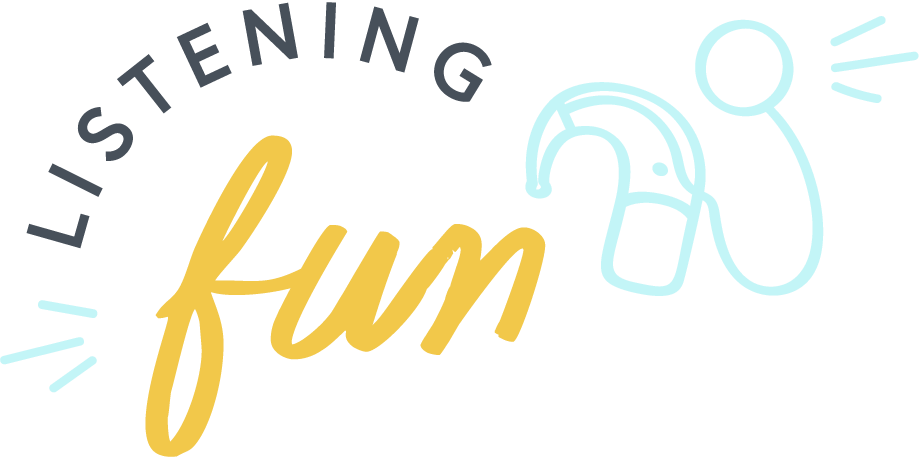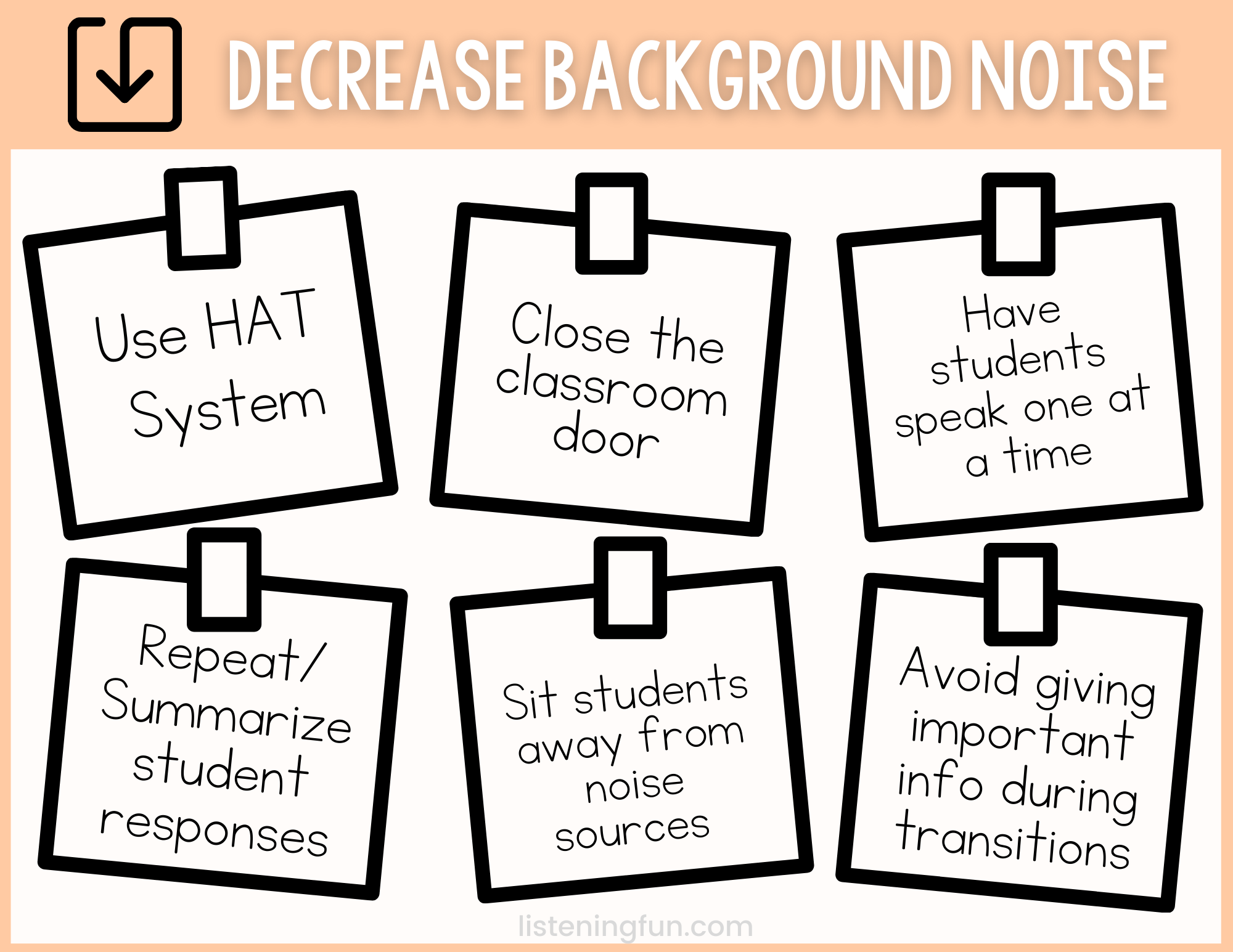Teacher In-Service Training Tips
One of the most important jobs for itinerant Teachers of the Deaf is giving a teacher in-service training at the beginning of the year. The purpose of the in-service training is to give classroom teachers some background information on hearing loss and its impact on the student’s education. This blog will discuss what’s typically included in the teacher in-service, tips for giving an impactful presentation, and links to resources you can include.
Topics Included in the Teacher In-Service Training
In-service trainings vary based on the age and needs of the students. These tips will be geared towards students using listening and spoken language that are mainstreamed in their home district. Generally speaking, most presentations include:
Introduction to you (the Teacher of the Deaf) and your role, how often you’ll be there, and your contact information.
Overview of student’s hearing. I show a familiar sounds audiogram and describe what the child hears without their technology. I use this opportunity to stress the importance of having functioning technology at all times.
Demonstrations of hearing level and hearing assistance technology (FM, DM, CAD, etc.) More on this later.
Hearing technology: Brief explanation of what type of personal and classroom technology the student uses.
Normal hearing vs. hearing with hearing aids or cochlear implants. I tend to go into more detail for cochlear implant users because it’s significantly different. For hearing aid users, I stress that they are listening through a microphone that picks up all sound, not just sound that is important.
Background noise: I usually pause and listen for any ambient noise in the classroom where I am presenting, and point it out to the group. I discuss sources of background noise in the classroom, including things they might not think of like a fan or chair legs. We then discuss how background noise affects children with hearing loss.
Accommodations: more on this later.
Problems faced by children with hearing loss: This varies a lot based on the student and age level. For preschool-age children, I talk about how language is “caught not taught”, how listening and speaking are precursors to reading and writing, etc. For older children, I often discuss the need to preview and review vocabulary due to a lack of incidental learning. For students with unilateral hearing loss, I discuss how this might look like selective hearing or not paying attention. This is one area where I focus on issues that are relevant to the student instead of giving a laundry list of issues, some of which might not be applicable.
Listening fatigue: It is worth it to have a separate slide on what listening fatigue is and how it manifests. Students may become tired, frustrated, or seem like they are not paying attention. We discuss the need for listening breaks and what that might look like in their class.
Self-advocacy: I tell the teachers that it is partially the student’s responsibility to ask for help and maintain their equipment. However, since students with hearing loss may not always be visibly struggling, it’s important for teachers to check in with them to make sure they understand important concepts. We discuss how the teachers and I can work together to foster self-advocacy skills in the student so that they can express when they need help. This leads nicely into the last slide.
Team approach: I like to end on this idea of a team approach and present myself as a resource to the teachers instead of another thing they need to worry about.
How to Give an Impactful In-service Training
Everyone has different personalities and ways of delivering presentations. These are a few tips to make your presentation impactful and actionable.
Know Your Priorities
Decide on what is the most important information for the teachers to learn in order to teach the child effectively, and then build your presentation around those things.
For example, there are many accommodations that help students with hearing loss, but they boil down to two main areas: decreasing background noise and increasing visuals. I like to show these charts so that when I go through the list, they are organized in some way that the teachers will remember the main idea: less noise, more visuals.
Show Respect for the Classroom Teachers
Classroom teachers have a skillset separate from ours as itinerants, and it’s helpful to acknowledge that. I try to relate to the strategies they are already using. For example, I use phrases such as, “As a third-grade teacher you already know how helpful it is to repeat student answers to the class. Now that’s extra important because you’ll be repeating it into the FM microphone…”
I also remind them that they are the expert in their content area, and it’s my job to support them in their teaching, not change the way they do things. If they love group work, I can give strategies for helping the students hear their peers. If they show a lot of videos, I can show them captioning options.
I give these examples so that the teachers can see me as a resource to enhance their teaching rather than change it. I have noticed that going into the presentation with this attitude helps us set up a positive working relationship from the beginning.
Bring the Hearing Technology
If the child is using hearing assistance technology (DM, FM, CAD), learning how to effectively use that equipment is extremely important and is often a priority of my in-service training. If you can bring the equipment with you, it’s great to let the teachers see it and practice putting on the receivers, pressing the mute button, etc.
I show them common mistakes such as wearing the microphone too low or forgetting to mute it. Teachers are typically most worried about the equipment, and doing a hands-on demonstration is a great way to keep them engaged and assuage some of their concerns.
Demonstrations
There are many hearing loss demonstrations on YouTube. Use them, but do not overuse them. No one wants to watch a 10 minutes video in the middle of an in-service training. I find it helpful to play a little bit, then discuss how it’s relevant to your student. Demonstrations are impactful because they show instead of tell.
Here are some examples:
Bransford & Johnson Paragraph: Can you tell what this is about without knowing the title? This is how students with hearing loss feel when they miss a topic change.
Unilateral hearing loss simulation: demonstrates the challenge of hearing in background noise with unilateral loss and the challenge of localizing sound
Bransford & Johnson Paragraph: This paragraph was developed to research the effect of schema on comprehension. It is also a really good demonstration of how just a little bit of missing information (the title) hugely impacts your ability to understand the paragraph. I show the paragraph and then on the next slide show the title (Flying a Kite) and it’s usually a big aha moment. I use this to combat the idea that hearing “almost everything” is good enough. It is particularly useful for presentations on students with unilateral or mild hearing loss.
Connect to Past Experience
Check to see if they’ve worked with Deaf or hard of hearing students in the past. This can give you a jumping-off point for discussions. In my experience, many teachers have had one student a long time ago and they used some old FM system, and they are excited and interested in the new technology.
Include the Student
Older students can give the presentation or part of the presentation themselves (something you can practice at the end of the prior year). Alternatively, you can have the student write a “Dear future teacher” letter at the end of the year (I have a free template here) and share it with the teachers.
The classroom teachers want to do their best to support their students. Hearing from the student directly is so impactful because it puts a face to the strategies.
Handout the Highlights
I make a one-page handout for each student’s in-service with a space for notes. I personally believe that handing out too much paper is overwhelming to teachers and they will never look at it again. I include the student’s accommodations and basic instructions for the equipment.
I truly believe that less is more when it comes to handouts during in-services. If you give space to write notes, most teachers will jot down the information they need to remember. You can download mine for free here.
Final Thoughts
The in-service is a great opportunity to set up our students for success. It is often the one time a year that we have the classroom teacher’s undivided attention, and these tips can help you make the most of your time. If you have any tips or tricks, please feel free to leave them in the comments section!
Before writing this blog post, I asked all the wonderful teachers in my TOD Facebook group if they had any tips for in-services. Thank you to the following teachers who contributed their ideas to this article:
Bambi Lambert
Kristen Temprine, ListenwithKristen.com
Leanna Ross, @dhhdownsouth
Kelsey Funk
Caitlyn Novakovic
Rebecca Nicholas
Source:
Bransford, J D., & Johnson, M. K. (1972). Contextual prerequisites for understanding: Some investigations of comprehension and recall. Journal of Verbal Learning and Verbal Behavior, 11 (6), 717 - 726 .






